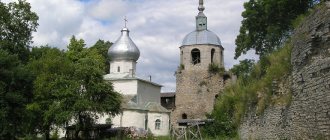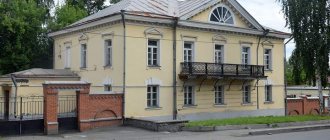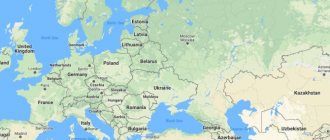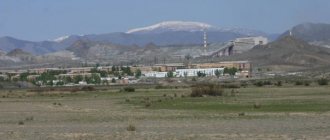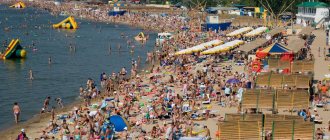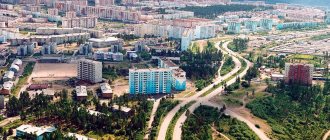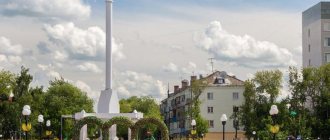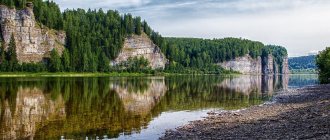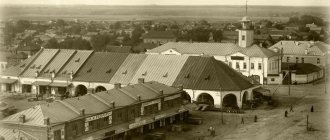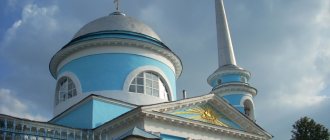| Alatyr city (Chuvash Republic) |
Alatyr
, a city of republican subordination in Russia, the administrative center of the Alatyr district of the Chuvash Republic, within the Alatyr deanery of the Alatyr diocese. Located in the Middle Volga region, on the left bank of the Sura River, at the confluence of the Alatyr River. Railway station of the Kazan branch of the Gorky Railway. Population - 35,298 people.
- On the map: Yandex.Map, Google map
Founded in 1552 by decree of Ivan IV the Terrible during his campaign against Kazan as a fortified point to protect the borders of the Moscow state at the mouth of the Alatyr River;
name after the river. The original form of the hydronym is Mordovian Ratorley; etymology has not been established. According to legend, Alatyr arose on the site where the royal camp was located.
Built to protect against the Kazan Tatars, Alatyr had been ruled by voivodes since the 16th century and was considered an important stronghold in the Volga region. In the 18th century it lost its military significance and became a trade and craft center.
In 1708, a suburb of Kazan, Alatyr was assigned to the Kazan province, from 1714 - in the Nizhny Novgorod province, from 1717 again in the Kazan province, from 1719 - the center of the province in the Nizhny Novgorod province. Since 1780 - the district town of Alatyr of the Simbirsk governorship (since 1796 - Simbirsk province).
In 1856, in the district town of Alatyr, Simbirsk province, there were 14 churches, 1,122 houses, 50 shops.
The economic importance of Alatyr increased due to the construction of the Moscow-Kazan railway. In August 1891, work began near the city, and on August 29, 1893, labor traffic was opened on the Sviyazhsk-Alatyr section.
The city has a memorial zone with stone mansions of the late 19th - early 20th centuries, local history and art museums. Arboretum. Alatyr branch of Chuvash State University named after. I.N. Ulyanov.
In the Alatyr region, grains, legumes, fodder crops, and potatoes are grown. They raise cattle (meat and dairy) and pigs. Deposits of peat, clay, sand, etc.
Alatyr. History and sights of the city
Alatyr is a city in the Chuvash Republic of Russia. The administrative center of the Alatyr region, which it is not part of. The urban district is formed by the city of Alatyr. Founded in 1552 as a fortification at the mouth of the Alatyr River, the name of the fortification from the hydronym. The original form of the hydronym is the Mordovian Ratorley, the etymology of which has not been established. The name comes from the ancient name of the stone “Alatyr-stone” - in Russian medieval legends and folklore, a sacred stone, “the father of all stones,” the navel of the earth, containing sacred writings and endowed with healing properties. It is often mentioned in Russian spells, mainly love spells, love spells, as “a mighty force that has no end.”
Geography of the city Alatyr is located in the Middle Volga region, on the left bank of the Sura River, near the confluence of the Alatyr tributary, 194 km south of Cheboksary. The city area is 41.7 km². The city has a rectangular layout. The historical center is on the corner of the hill closest to the confluence of the Sura and Alatyr. The development of the city was carried out mainly in the western and southern directions. In modern Alatyr, private buildings predominate. Two microdistricts built up with multi-storey buildings, Strelka and Zapadny, are located on the outskirts. In addition, multi-storey buildings were built in some areas of the central part of the city.
The climate is moderately cold. High rainfall, even in dry months. About 527 mm of precipitation falls annually. The average annual temperature is +4.0 °C. The least precipitation falls in February, with an average of 22 mm. In July, precipitation reaches its peak, with an average of 70 mm. The hottest month is July with a temperature of +19.7 °C. January is the coldest month, with an average temperature of −12.1 °C.
City `s history
Alatyr is a city with a long history. The emergence of the city in the 16th century is associated with the Russian colonization of the Volga region. After the founding of Nizhny Novgorod in 1221, the borders of Russian lands began to move to the east, and already in the 14th century, the border of Russia with the Golden Horde passed along the left bank of the Sura, which, being a natural water barrier, was also actively built up with cities and forts. The founding date of the city is considered to be 1552 (in some sources, August 4), and it is associated with the first chronicle mention. The chronicle, speaking about Ivan IV’s decision to march on Kazan, mentions Alatyr. At first, “fortress” and “city” were equivalent concepts. Without a city there was no fortress, without a fortress there was no city. Fortresses were formidable structures for their time.
The population of the city, which consisted of military service people (nobles and children of boyars, gunners, fighters, archers and Cossacks, etc.), arrived here “from different places.” Starodubtsy and Roslavtsy served here at the beginning of the 17th century. military personnel are transferred from Ryazan, Tula, Aleksin, Mtsensk, Novosil, Chernya, Plov, Solov and other cities.
Nobles and boyar children predominated. The nobles were divided into Moscow nobles, who had estates in the Moscow district, and policemen, who carried out military service along the way. The most combat-ready force were the archers, who were also divided into Moscow and policemen.
Initially, Alatyr was part of the cities of the so-called “Kazan category” and was governed by the Order of the Kazan Palace. In 1583, the category included Kazan, Nizhny Novgorod, Astrakhan, Vasilsursk, Kozmodemyansk, Cheboksary, Sviyazhsk, Tetyushi, Laishev, Alatyr, Arzamas, Kurmysh, Kokshaisk, Alat, Arsk.
For more than four centuries, the city was developed and formed as an administrative, spiritual, cultural, commercial, and, from the beginning of the 19th century, an industrial center of Alatyr district. At different times the city was part of the Kazan, Nizhny Novgorod and Simbirsk provinces, and since 1925 it became part of Chuvashia.
City population
As of January 1, 2022, in terms of population, the city was in 455th place out of 1,115 cities in the Russian Federation. After the construction of the Moscow-Kazan Railway in 1893, which passed through Alatyr, the city’s population began to grow rapidly: in 1897 it was 12,209 people, and by 1915 it doubled, reaching 25,144 people. and turning Alatyr into the largest city on the territory of modern Chuvashia. For comparison: the population of Cheboksary at the beginning of the 20th century was about 5,500 inhabitants).
In 1920, 19,668 residents (9,486 men and 10,182 women) lived in the city in 2,909 properties, and according to the 1923 census, 17,867 people lived (8,457 men and 9,410 women). After 1917, the city's population growth rate decreased markedly, and since the early 1990s, the city's population began to decline. According to the 2010 population census, the absolute majority of the population in Alatyr is Russian, Mordovians, Chuvash and Tatars also live.
Nature of the city
Alatyr is one of the greenest cities in Chuvashia. Within the city boundaries there are specially protected natural areas with a total area of 390.7 hectares. In the southern part of the city one can see the Oak Grove with the remains of a monastery - a very picturesque place overlooking the Sura River, the confluence of the Sura and the Abyss. The total area of all green areas and plantings in Alatyr is 4,699 thousand square meters, the area of city parks and squares is 149,204 square meters. The share of green areas for various purposes within the city limits is 45.8%, the area of green areas within urban development is 112 square meters. per person.
Green spaces in the city are represented mainly by squares and parks, which create a unique landscape of the ancient Russian city. The most attractive and visited are the city park (Komsomola St.), Veterans Park (Pervomaiskaya St.), children's park "Fairy Tale" (Goncharova St.), and linden alley (Pervomaiskaya St.). In total, there are 14 parks and squares in Alatyr.
Architecture and sights of the city
The city's almost 500-year history has left a legacy of a large number of monuments of religious, civil and industrial architecture. Today in Alatyr there are about 90 buildings and structures that have historical and cultural value. Two of them are monuments of federal significance. Residential buildings, churches and monasteries were built in different historical periods, and are often unique objects. Local traditions of wooden architecture and artistic woodworking, combined with the stylistic techniques of classicism, modernism, and eclecticism, create a unique flavor of the ancient streets and alleys of Alatyr. This, in turn, makes even more pressing the issue of the need to take comprehensive large-scale measures to restore and reconstruct the historical center of the city in order to preserve the unique, original culture of the Alatyr region.
Among the most striking and significant monuments of the city of Alatyr are:
Residential and public buildings
- Residential building at the address: Lenin street, building 7. Alatyr
- treasury (mid-19th century),
- house of the Popov merchants (late 19th century, Kirova St., 1),
- house of merchant Antonov (1859, Gorshenina St., 28),
- store building (1900s, modern, Lenin St., 10),
- house of merchant N.P. Lebedev (1898),
- zemstvo government (mid-19th century),
- assembly of the nobility (since 1911 cinema "Pate"),
- printing house of S. F. Rodionov (1882, rebuilt in 1913),
- Shtankovsky's house (printing house and bookstore of S.K. Pshenichnikov),
- building of a real school (late 19th century),
- city school (1908-1911, architect F. O. Livchak),
- women's gymnasium (1908),
- county courthouse (1912),
- religious school (late 19th century),
- tavern building (1908, during Soviet times the building housed dining room No. 2),
- residential building on the street Lenin (XIX century, monument of wooden architecture),
- Hotel “Siberia” (1900s, Komsomol St., 69, in disrepair, 2nd floor destroyed);
Industrial architecture
- state wine warehouse (1898, architect Pavlovsky, Morgulin, Treskin, now the building houses a railway transport technical school),
- water tower (1912),
- railway depot of Alatyr station (1893),
- production shops of the steam locomotive repair plant (1893, currently Alatyr Mechanical Plant).
Famous townspeople
Vitvinsky, Valentin Fedorovich - artilleryman, Hero of the Soviet Union.
Gorshenin, Konstantin Petrovich - the first Prosecutor General of the USSR.
Krylov, Alexey Nikolaevich - shipbuilder, specialist in the field of mechanics, mathematician, academician of the USSR Academy of Sciences.
Mazyrin, Viktor Aleksandrovich - architect, author of the Arseny Morozov mansion in Moscow.
Tsvetkov, Ivan Evmenievich - philanthropist, collector, founder of an art gallery.
Erzya, Stepan Dmitrievich - Russian and Soviet sculptor[46].
Sudaev, Alexey Ivanovich - Soviet weapons designer. Laureate of the Stalin Prize, second degree.
Zoya Ivanovna Parfenova (Akimova) - participant in the Great Patriotic War, deputy squadron commander of the 46th Guards Night Bomber Aviation Regiment of the 325th Night Bomber Aviation Division of the 4th Air Army of the 2nd Belorussian Front, guard senior lieutenant. Hero of the Soviet Union.
Kikin, Pyotr Andreevich - hero of the Patriotic War of 1812.
Makarov, Pyotr Grigorievich (1922-2006) - major of the Soviet Army, participant in the Great Patriotic War, Hero of the Soviet Union (1945).
Content
- 1 Geography
- 2 Coat of arms and flag of the city
- 3 History
- 4 Demographics
- 5 Architecture and landmarks 5.1 Orthodox churches and monasteries
- 5.2 Residential and public buildings
- 5.3 Industrial architecture
- 7.1 Secondary vocational education
Demographics[edit | edit code]
The population of Alatyr changed as follows: in 1795, 2,830 people lived in the city, in 1825 - 3,565. After the construction of the Moscow-Kazan railway in 1893, which passed through Alatyr, the population of the city began to grow rapidly: in 1897 it amounted to 12,209 people, and by 1915 it doubled, reaching 25,144 people. and turning Alatyr into the largest city on the territory of modern Chuvashia (for comparison, the population of Cheboksary at the beginning of the 20th century was about 5,500 inhabitants).
After 1917, the growth rate of the city's population decreased noticeably: in 1939 the number of residents was 29,800 people, in 1959 - 36,900 people, in 1979 - 45,300 people, in 1989 - 47,600 people. The crisis in the country led to the fact that since the beginning of the 1990s, the city's population began to decrease and, according to the 2002 census, amounted to 43,000 people.
Education[edit | edit code]
Secondary vocational education[edit | edit code]
- Alatyr Automobile and Highway College
- Alatyr College of Railway Transport (branch of Samara State Transport University)
- Alatyr Agricultural College
Primary vocational education[edit | edit code]
- RGOU NPO "Vocational School No. 3 of Alatyr"
General educational institutions[edit | edit code]
- List of schools in Alatyr
History[edit | edit code]
The official founding date of the city is 1552 - the time of the first mention of Alatyr in the Patriarchal (Nikonov) chronicle:
And the sovereign taught him to think with his brother, with Prince Vladimir Andreevich and with the boyars and with all the governors, how to go to Kazan and to which places; and the sovereign ordered them to go in two, with room for the people, and for the sovereign himself to go to Volodymer and Murom, and the governor to let him go to Rezan and Meshchera, and to go to the Field behind Alatar.
[2]
This text is one of the fragments of the description of the last (third) campaign of Ivan IV to Kazan, which ended with the conquest of the Kazan Khanate.
The mention of Alatyr along with other cities allowed historians to suggest that by that time the city already existed. In particular, in the “Geographical Lexicon” of F. A. Polunin, information is provided indicating that Alatyr was founded back in the 13th century, during the reign of Yuri Vsevolodovich Vladimirsky, as a fort on the site of a Mordovian village, which was moved by John IV in the 16th century to a new, more convenient place for the fortress [3].
Disagreements among historians also arise when, in reality, the Russian army led by the Tsar passed through the territory of the present city. Thus, one of the researchers of the history of the Sur region, V.M. Shishkin, believes that Alatyr could have been founded by Ivan Vasilyevich during not the last, but the first Kazan campaign (that is, in 1547-1548) [4]
The only unconditional and indisputable fact is that a settlement on the site of the modern city existed long before it was mentioned in Russian chronicles. This is confirmed by the found remains of an ancient settlement (presumably belonging to one of the Mordovian tribes), and archaeological finds (including those from the 12th century), and the name of the Erzyan settlement Sandulei preserved in the toponymy of Alatyr (Erzya - Syangley, “Fork of the River”).
One way or another, no later than 1552 (according to V. E. Krasovsky - August 4, 1552 [5]) Tsar John Vasilyevich approached the high bank of the Sura at the confluence of the Alatyr River with his army and “... ordered immediately at yourself... to build a city of logs and strengthen it according to all the rules of the then serfdom, calling it by the name of the river - Alatyr" [5]. It was from this time that the history of the city of Alatyr began as a Russian military, cultural and religious outpost on the eastern borders of the Moscow state.
Together with Yadrin, Vasilsursk and Kurmysh (currently a village on the other side of the Sura, in the Nizhny Novgorod region), these forts became conductors of the military-administrative influence of Nizhny Novgorod - the arm of the young Russian state, facing the east, to the lands of the “mountain Cheremis”. Mountain Cheremis, that is, local Chuvash and right-bank Mari, in turn, a year before the capture of Kazan, were accepted “under the arm” of Ivan Vasilyevich, and this, according to historians, decided the fate of the Kazan Khanate. So, the 450th anniversary of Chuvashia’s entry into Russia, celebrated in June 2001, the 450th anniversary of Alatyr in 2002 and the 450th anniversary of the capture of Kazan are very closely related.
Alatyr. Simbirskaya street. Photo beginning XX century
After Russian Simbirsk, founded on the site of the Bulgar Senber (in Chuvash the city is still called “Chěmpěr”), became a large administrative center, the Mountain Side (almost the territory of modern Chuvashia), “hanging” between Nizhny and Kazan, found itself “stretched” between the vertices of the triangle - Simbirsk, Nizhny Novgorod, Kazan. Its southern regions, as well as the south of the lower Posurye with Alatyr (that is, the southern part of the Alatyr province), transferred from Kazan to Nizhny and back, in 1780 went to the Simbirsk governorship (then the province). In the same year, Alatyr became a city. By the way, most of Chuvashia, at least culturally, was oriented toward Simbirsk in the 19th century (the influence of N. Novgorod did not go further than Yadrin, and Kazan was a Tatar and Islamic center). The national Chuvash intelligentsia grew up in Simbirsk, therefore, this city is the birthplace of the modern Chuvash national identity. In this regard, Alatyr, a city of two monasteries, a large missionary center (focused on the Chuvash and Mordovians), became a cultural outpost of Simbirsk.
The Soviet government made its own adjustments to the situation: the young national autonomies “cultivated” their own political, economic and cultural centers. This is how Cheboksary and Saransk arose. Accordingly, the triple periphery, which included all of present-day Chuvashia, half of Mordovia, the southeast of the Nizhny Novgorod and northwestern Ulyanovsk regions, ceased to exist. A relic of this territory is the common periphery of four cities (Nizhny Novgorod, Cheboksary, Ulyanovsk, Saransk) with a center in Alatyr, the intersection of different economic zones of influence, historical, cultural regions and national areas. From here to Saransk 145 km, to Ulyanovsk 160 km, to Cheboksary 185 km.
The administrative-territorial delineation carried out in the 1920s led to the elimination of such peripheral territories. Parts of the Alatyr district, with which the city still has close ties, were transferred to Nizhny Novgorod, Saransk and Ulyanovsk, but Alatyr itself - a Russian city on Mordovian lands (many Russians here are assimilated Mordovians) - after some hesitation, completely disregarding the opinion of the population and despite the protests of the Alatyr executive committee and the Ulyanovsk provincial executive committee, on September 7, 1925 it was transferred to Chuvashia.
Sources[edit | edit code]
- Decision of the Assembly of Deputies of Alatyr of the IV convocation dated May 29, 2009. No. 40/32-4 “On approval of the historical coat of arms and flag of the city of Alatyr of the Chuvash Republic”
- Complete collection of Russian chronicles. – T. XIII. – P. 191.
- Polunin F. A. “New and complete geographical dictionary of the Russian state or Lexicon...”. Ed. 2, part I, - M., 1788, p. 15
- Shishkin V. M. About Alatyr and the Alatyr people. Issue 2. - Cheboksary, 2006.
- ↑ a b Krasovsky V. E. Alatyr antiquity. Travel notes on archeology and history of the Alatyr region. - Simbirsk, 1899.
Economics[edit | edit code]
| Attention! This article is not of satisfactory quality, but its subject should be covered in the Tradition. You can help the Project by rewriting it in an encyclopedic style. Thank you. |
Economically, the city began with fur trading, farming, and military service. In the 18th century, crafts and trade began to play a major role. And in the 19th century, Alatyr began to develop, specializing in servicing “controlled” territories, trade (an old merchant city) and processing timber that was rafted down the Alatyr River from local (East Mordovian) forests. At the end of the 19th century, the city became famous for fairs and agricultural exhibitions. And at the beginning of the 20th there were 24 factories and plants.
File:Alatyr Most.jpg Alatyr. Crash on the Sindyachkin railway bridge. Photo beginning XX century.
In 1893, a railway line from Ruzaevka to Sviyazhsk passed here (part of the road aimed at connecting Moscow with Kazan and further with the eastern parts of the country), depots and railway workshops were built (later a steam locomotive repair plant), which remained the only large industrial enterprise on the territory of modern Chuvashia up until the 1930s. The construction of the railway gave impetus to the active development of industry and trade and led to a significant increase in population.
Before the war, the local industry developed on the old pre-revolutionary foundation, but in the 50-60s, an electromechanical plant was built here (causing irreparable damage to the historical one), on the basis of the former Central Repair Workshops (repair of forestry equipment). But such a high-tech industry did not receive further development. A paper mill was put into operation in 1965. However, since the late 1960s, “stagnation” in the development of the urban economy has become increasingly noticeable and the first signs of the beginning lag and decline of Alatyr against the background of other cities of the Chuvash Autonomous Soviet Socialist Republic appear.
Inattention to the problems of Alatyr and disrespect for its interests during the years of Soviet power led to the fact that by 1980 the largest and most developed city of the republic had become only the 4th largest in terms of population and economic importance. Alatyr developed at an extremely low pace: housing construction was financed on a residual basis, its volumes were significantly less than in other cities of Chuvashia, and did not even satisfy current needs; from 1970 to 1980, not a single new industrial enterprise was built, and existing production facilities were not expanded. Chronic underfunding of work on the improvement and development of urban infrastructure has led to a serious lag in Alatyr in this area (there are still very few paved roads in the city and there is no normal street lighting system).
In 1976, a new master plan for Alatyr was developed. The previous one was drawn up in 1936, but was never implemented. The new master plan suffered the same fate: the planned industrial enterprises and modern residential areas with developed infrastructure were not built, the transport system was not developed, the necessary base was not created to increase the volume of construction, etc. Accordingly, the main point was not fulfilled The plan is to increase the city's population by more than 2 times by the year 2000 (that is, from 46,400 people on January 1, 1975 to 90,000 - 100,000 people in 2000). The problems that had accumulated over several decades worsened even more during the crisis of the 1990s, were replenished with new ones, and, for the most part, have not been resolved to this day.
In the 90s, all enterprises were hit by a crisis. Naturally, ties with the military-industrial complex, high technology, and the general poverty of the republic had an impact. From 1999 to 2000, trends towards some improvement appeared. However, many enterprises were irretrievably lost (for example, furniture and music factories closed, shipping on the Sura ceased), and those that survived are experiencing difficulties of a systemic nature: lack of funds for the reconstruction of fixed assets, an acute shortage of qualified specialists and workers, low demand for products from high-tech industries and etc. A serious obstacle to development is also the fact that Alatyr has the lowest wage level in the republic.
One of the main resources for the potential development of Alatyr is the education sector. The city has 11 schools, agricultural and road technical schools, and a railway transport technical school. In addition to the branch of the Chuvash State University, there are branches of the Moscow and St. Petersburg Humanitarian Institutes. In the 20-30s, there were many different educational institutions in Alatyr (institute of natural history, art and engraving school, teacher's institute, etc.). In the 40s, many of them were transferred to Cheboksary, some were closed, some still exist today. Before the revolution, the city had: a real school, men's and women's gymnasiums, and a religious school. There is a local history in the city of a “legendary nature”: a grenadier regiment was stationed here, and since then there has been a special breed of people here - the girls are the most beautiful, and the men are the most determined, at the moment, in all of Chuvashia. This once again characterizes the Alatyr people as a special local community, separate from everyone else. By the way, the main street of the city is Moskovskaya.
Alatyr is a special city. The center of the actual Russian outback, of which few have survived, a unique geographical peripheral zone. Alatyr is a combination of strange, amazing and one-of-a-kind things. Advanced industry and active religious life, a remarkable natural and cultural landscape, a cultural, ethnic and historical reserve, a reserve of special local regional consciousness. This city is noble, rich, stubborn, stately, strong and at the same time quiet and cozy.
2008 Volume of shipped goods of own production, work and services performed in-house by type of activity, manufacturing thousand rubles: 2.678 billion rubles.
Famous townspeople[edit | edit code]
- Anikin, Viktor Ivanovich - architect
- Gorshenin, Konstantin Petrovich - 1st Prosecutor General of the USSR
- Kikin, Pyotr Andreevich - Secretary of State of the Emperor, participant in the Patriotic War of 1812, author of the idea of building the Cathedral of Christ the Savior in Moscow
- Kochetov, Alexander Vasilievich - pilot, Hero of the Soviet Union
- Krylov, Alexey Nikolaevich - shipbuilder, specialist in the field of mechanics, mathematician, academician of the USSR Academy of Sciences
- Mazyrin, Viktor Aleksandrovich - architect, author of Arseny Morozov's mansion in Moscow, known as the House of Peoples' Friendship.
- Sudaev, Alexey Ivanovich - Soviet weapons designer, major
- Shestakov, Nikolai Yakovlevich - playwright
- Shidlovsky, Andrey Borisovich - mathematician, Honored Scientist of the RSFSR, Honored Professor of Moscow State University
- Nefedov (Erzya), Stepan Dmitrievich - Russian and Soviet sculptor

